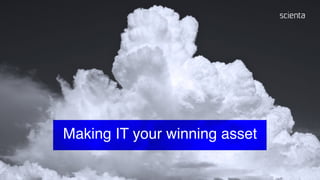From Capabilities to Services: Modelling for Business-IT Alignment v.2 ext
- 1. Making IT your winning asset
- 2. From Capabilities to Services Modelling for Business-IT Alignment
- 3. ŌĆ£Thus God knows the world, because He conceived it in His mind, as if from the outside, before it was created, and we do not know its rule, because we live inside it, having found it already made.ŌĆØ -William of Baskerville ŌĆ£The Name of the RoseŌĆØ miniseries 2019
- 4. Source: Sam Homer, https://businessways.com/organization-need-businessit-alignment/@trondhjort
- 5. @trondhjort Source: "EDA: SOA through the looking glass", Udi Dahan 2009
- 6. Source: "EDA: SOA through the looking glass", Udi Dahan 2009@trondhjort
- 8. Theodor Kittelsen. Soria Moria slott , 1900
- 9. @trondhjort Credit & Copyright: Robert Gendler
- 10. @trondhjort Source: XKCD, https://xkcd.com/54/
- 11. @trondhjort
- 13. @trondhjort
- 14. @trondhjort
- 15. @trondhjort Source: Baruco 2012: Micro-Service Architecture, by Fred George
- 16. @trondhjort -Udi Dahan, 2010 ŌĆ£A service is the technical authority for a specific business capability.ŌĆØ Photo: DDD Europe 2017
- 17. Source: ŌĆ£From Capabilities to Services: Moving from a Business Architecture to an IT ImplementationŌĆØ, Homann & Tobey 2006@trondhjort
- 18. @trondhjort ŌĆ£A business capability represents the ability for a business to do something.ŌĆØ Source: The Open Group 2016 in G161, ŌĆśOpen Group Guide: Business CapabilitiesŌĆś ŌĆ£A business capability is a particular ability or capacity that a business may possess or exchange to achieve a specific purpose or outcome.ŌĆØ
- 19. @trondhjort
- 23. The What, not the How @trondhjort
- 27. A Capability is notŌĆ” A department A business process A function A data entity An IT system @trondhjort
- 28. A Capability is defined byŌĆ” People Process Information Tools @trondhjort
- 30. @trondhjort The Enterprise Level 1 Level 2 Level 3 4
- 31. Source: Example by Ulrich Kalex, The Open Group@trondhjort The Enterprise Corporate Management Market Dev. Oversight Delivery Product Dev. Support & Services
- 32. The Enterprise Source: Business Capability Management, Ulrich Kalex 2011@trondhjort Corporate Management Market Dev. Oversight Delivery Product Dev. Market Development Contact Man. Revenue Analysis Regional Market Man. Order and Contract Man. Market Analysis Support & Services Direct Marketing Channel Man. Sales Man.
- 34. Labour and Welfare @trondhjort Corporate Management Service development Assistive Employment assistance User management Portfolio management Employment assistance Social assistance Family assistance Statistics Pension assistance Benefits Unemployment assistance Employer support Sick leave assistance Employment service
- 35. Internet Service Provider @trondhjort Corporate Management Develop services Sell services Recommendations Build accesses Sell services Deliver services Insight Finance Outgoing sales Seller efficiency Incoming sales Planning
- 36. @trondhjort Name Service feasibility check Description The ability to check what type of technical access infrastructure is available at a given address. Components Roles User: Customer Business unit: Technical infrastructure Processes Feasibility search Service inventory Information Technical address, networks, access types, broadband speed, ŌĆ” Tools Kapaks, search component, address index.
- 37. Using the Business Capability Model
- 38. @trondhjort Business consulting Business analysis Strategic planning Heat maps
- 39. @trondhjort Source: The Open Group 2016 in G161, ŌĆśOpen Group Guide: Business CapabilitiesŌĆś
- 40. @trondhjort Business consulting Business analysis Strategic planning Heat maps Data Management Organisation Planning
- 41. @trondhjort ŌĆ£Products-mode works best when teams are organized to be simultaneously aligned with business relevant capabilities and with enterprise architecture boundaries.ŌĆØ Source: "Products Over Projects", Sriram Narayan 2018 ŌĆ£Without the former, they may lose alignment with business goals. Without the latter, they lose out on autonomy.ŌĆØ Product over projects
- 42. @trondhjort Source: Alignment at Scale, Henrik Kniberg 2016
- 43. @trondhjort Source: Dan Sloan, https://twitter.com/danielhsloan/status/1167758028084535296
- 44. @trondhjort Business consulting Business analysis Strategic planning Heat maps Data Management Technical design Organisation Planning
- 46. Divide and Rule
- 47. Source: ŌĆ£Testing in Production at ScaleŌĆØ, Amit Gud at SREcon
- 48. Source: ŌĆ£From Capabilities to Services: Moving from a Business Architecture to an IT ImplementationŌĆØ, Homann & Tobey 2006@trondhjort
- 49. @trondhjort -Mel Conway, 1968 ŌĆ£ŌĆ”organizations which design systems ... are constrained to produce designs which are copies of the communication structures of these organizations.ŌĆØ
- 52. ŌĆ£A complex system that works is invariably found to have evolved from a simple system that worked. A complex system designed from scratch never works and cannot be patched up to make it work. You have to start over with a working simple system.ŌĆØ -John Gall
- 53. From Capabilities to Services Modelling for Business-IT Alignment
- 54. Making IT your winning asset @trondhjort






















































